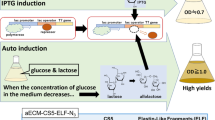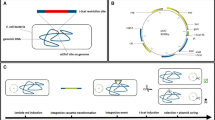Abstract
Bacterial protein secretion is important in the life cycles of most bacteria, in which it contributes to the formation of pili and flagella and makes available extracellular enzymes to digest polymers for nutritional purposes and toxins to kill host cells in infections of humans, animals and plants. It is generally accepted that nonpathogenic laboratory strains of Escherichia coli, particularly K12 strains, do not secrete proteins into the extracellular medium under routine growth conditions1,2. In this study, we report that commonly used laboratory strains secrete YebF, a small (10.8 kDa in the native form), soluble endogenous protein into the medium, challenging the status quo view that laboratory strains do not secrete proteins to the medium. We further show that 'passenger' proteins linked to the carboxyl end of YebF are efficiently secreted. The function of YebF is unknown, but its use as a carrier for transgenic proteins provides a tool to circumvent toxicity and other contamination issues associated with protein production in E. coli.
This is a preview of subscription content, access via your institution
Access options
Subscribe to this journal
Receive 12 print issues and online access
$209.00 per year
only $17.42 per issue
Buy this article
- Purchase on Springer Link
- Instant access to full article PDF
Prices may be subject to local taxes which are calculated during checkout




Similar content being viewed by others
Accession codes
References
Pugsley, A.P. & Francetic, O. Protein secretion in Escherichia coli K-12: dead or alive? Cell Mol. Life Sci. 54, 347–352 (1998).
Shokri, A., Sanden, A.M. & Larsson, G. Cell and process design for targeting of recombinant protein into the culture medium of Escherichia coli. Appl. Microbiol. Biotechnol. 60, 654–664 (2003).
Brokx, S.J. et al. Genome-wide analysis of lipoprotein expression in Escherichia coli MG1655. J. Bacteriol. 186, 3254–3258 (2004).
Ohdan, K. et al. Characteristics of two forms of alpha-amylases and structural implication. Appl. Environ. Microbiol. 65, 4652–4658 (1999).
Chang, A.C.Y. & Cohen, S.N. Construction and characterization of amplifiable multicopy DNA cloning vehicles derived from the P15A cryptic miniplasmid. J. Bacteriol. 134, 1141–1156 (1978).
Francetic, O., Belin, D., Badaut, C. & Pugsley, A.P. Expression of the endogenous type II secretion pathway in Escherichia coli leads to chitinase secretion. EMBO J. 19, 6697–6703 (2000).
He, S.Y., Lindeberg, M., Chatterjee, A.K. & Collmer, A. Cloned Erwinia chrysanthemi out genes enable Escherichia coli to selectively secrete a diverse family of heterologous proteins to its milieu. Proc. Natl. Acad. Sci. USA 88, 1079–1083 (1991).
Poquet, I., Faucher, D. & Pugsley, A.P. Stable periplasmic secretion intermediate in the general secretory pathway of Escherichia coli. EMBO J. 12, 271–278 (1993).
Stathopoulos, C. et al. Secretion of virulence determinants by the general secretory pathway in gram-negative pathogens: an evolving story. Microbes Infect. 2, 1061–1072 (2000).
Francetic, O. & Pugsley, A.P. The cryptic general secretory pathway (gsp) operon of Escherichia coli K-12 encodes functional proteins. J. Bacteriol. 178, 3544–3549 (1996).
Thanassi, D.G. & Hultgren, S.J. Multiple pathways allow protein secretion across the bacterial outer membrane. Curr. Opin. Cell Biol. 12, 420–430 (2000).
Lattemann, C.T., Maurer, J., Gerland, E. & Meyer, T.F. Autodisplay: functional display of active β-lactamase on the surface of Escherichia coli by the AIDA-I autotransporter. J. Bacteriol. 182, 3726–3733 (2000).
Robb, R.J. Interleukin 2: the molecule and its function. Immunol. Today 5, 203–209 (1984).
Masui, Y. et al. Microheterogeneity of recombinant products: human interleukin 1α and 1β. in Current Communications in Molecular Biology—Therapeutic Peptides and Proteins. (eds. Marshak, D. and Liu, D.) 167–172 (Cold Spring Harbor Laboratory Press, Cold Spring Harbor, New York, 1989).
Sambrook, J. & Russell, D.W. Molecular cloning, a laboratory manual, edn. 3 (Cold Spring Harbor Laboratory Press, Cold Spring Harbor, NY, 2001).
Strack, B., Lessel, M., Calendar, R. & Lanka, E. A common sequence motif, -E-G-Y-A-T-A-, identified within the primase domains of plasmid-encoded I- and P-type DNA primases and the α protein of the Escherichia coli satellite phage P4. J. Biol. Chem. 267, 13062–13072 (1992).
Tabor, S., Huber, H.E. & Richardson, C.C. Escherichia coli thioredoxin confers processivity on the DNA polymerase activity of the gene 5 protein of bacteriophage T7. J. Biol. Chem. 262, 16212–16223 (1987).
Zhang, G. & Weiner, J.H. CTAB-mediated purification of PCR products. Biotechniques 29, 982–986 (2000).
Neu, H.C. & Heppel, L.A. The release of enzymes from Escherichia coli by osmotic shock and during the formation of spheroplasts. J. Biol. Chem. 240, 3685–3692 (1965).
Schagger, H. & von Jagow, G. Tricine-sodium dodecyl sulfate-polyacrylamide gel electrophoresis for the separation of proteins in the range from 1 to 100 kDa. Anal. Biochem. 166, 368–379 (1987).
Lei, H. et al. Induction of potent antitumor response by vaccination with tumor lysate-pulsed macrophages engineered to secrete macrophage colony-stimulating factor and interferon-g. Gene Therapy 7, 707–713 (2000).
Acknowledgements
J.H.W. is a Canada Research Chair in Membrane Biochemistry. This work was supported by the Canadian Institutes of Health Research and the Alberta Heritage Foundation for Medical Research. We thank the following people for their valuable contribution to this study. Len Wiebe and Aihua Zhou provided technical assistance with the hIL-2 bioassay. Chris Bleackley, Irene Shostak and Jonathan Hooton provided the materials and methods for the hIL-2 bioassay. Lorne Burke and Paul Semchuk provided technical support for HPLC and mass spectrometry. We thank Biomira for kindly allowing us to use plasmid pBM806.
Author information
Authors and Affiliations
Corresponding author
Ethics declarations
Competing interests
The authors declare no competing financial interests.
Rights and permissions
About this article
Cite this article
Zhang, G., Brokx, S. & Weiner, J. Extracellular accumulation of recombinant proteins fused to the carrier protein YebF in Escherichia coli. Nat Biotechnol 24, 100–104 (2006). https://doi.org/10.1038/nbt1174
Received:
Accepted:
Published:
Issue Date:
DOI: https://doi.org/10.1038/nbt1174
This article is cited by
-
Yields and product comparison between Escherichia coli BL21 and W3110 in industrially relevant conditions: anti-c-Met scFv as a case study
Microbial Cell Factories (2023)
-
A bottom-up approach towards a bacterial consortium for the biotechnological conversion of chitin to l-lysine
Applied Microbiology and Biotechnology (2021)
-
Accelerated directed evolution of dye-decolorizing peroxidase using a bacterial extracellular protein secretion system (BENNY)
Bioresources and Bioprocessing (2019)
-
Soluble versions of outer membrane cytochromes function as exporters for heterologously produced cargo proteins
Microbial Cell Factories (2019)
-
Extracellular production of recombinant N-glycosylated anti-VEGFR2 monobody in leaky Escherichia coli strain
Biotechnology Letters (2019)



